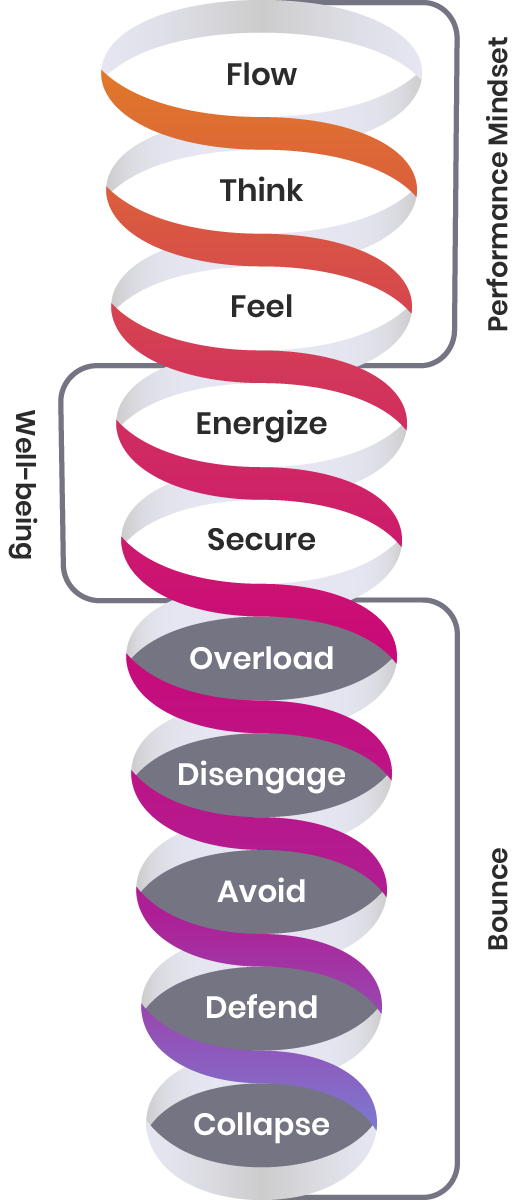
What is the Resilience Spiral?
What is the Resilience Spiral?
Resilience is integral to personal and professional growth, and understanding it can significantly enhance our ability to navigate life’s challenges. Dr. Sven Hansen, the founder of the Resilience Institute, developed the Resilience Spiral to provide a structured framework for understanding and enhancing resilience. This model is built on the principles of neurobiology, physiology, and evolutionary biology, aiming to help individuals and organizations thrive in adversity.

The Foundation of the Resilience Spiral
Resilience, as defined by Dr. Hansen, is the learned ability to:
1. Bounce forward fast in adversity
2. Grow physical, emotional, and mental strengths
3. Connect with oneself, others, and nature
4. Discover flow in the application of skill to meaningful challenges
These capabilities are essential for navigating the complexities of life, whether for individuals, businesses, or communities. Resilience is not just about surviving; it is about thriving and evolving through adversity.
Understanding the Resilience Spiral
The Resilience Spiral is a diagnostic and development model that describes our quality of experience and altitude in life. Our altitude can be high, where we feel clear, energized, and focused, or low, where we experience pain, suffering, and negativity. The journey through the spiral involves moving up and down these states, influenced by our physical, emotional, and mental conditions.
Integral Approach in the Context of Spiral Models
In the context of the Resilience Spiral, “integral” means incorporating a comprehensive, inclusive approach that accounts for various dimensions of human experience. This concept draws inspiration from other spiral models like Spiral Dynamics and Integral Theory.
Spiral Dynamics, developed by Clare Graves, Don Beck, and Chris Cowan, explores the evolution of human values and consciousness. It has been applied in global negotiations, politics, medicine, and business. Similarly, Integral Theory, proposed by Ken Wilber, is one of the most comprehensive and inclusive frameworks, integrating insights from various fields to create a unified understanding of reality.
Dr. Hansen’s Resilience Spiral integrates these approaches by combining insights from neurobiology, physiology, and evolutionary biology with practical applications for resilience. This integration ensures a holistic understanding of resilience, addressing the physical, emotional, mental, and social dimensions of human experience.
Four Key Perspectives
Dr. Hansen’s model emphasizes four perspectives to enhance resilience:
Insight – Know Yourself
Insight involves understanding your current state by checking your body, emotions, and mind. This self-awareness is crucial for improving your altitude and engaging effectively with others. Accurate terminology and self-assessment tools, like the Resilience Spiral, help in this understanding.
Mastery – Raise Your Altitude
Mastery is about knowing how to improve your state once you have identified it. This involves specific biological adjustments, such as regulating your nervous system to restore calm and readiness. Building physical, emotional, and mental skills through practices like good sleep, emotional control, and focused attention is essential.
Empathy – Understand Others
Empathy is the ability to accurately read and respond to the physical, emotional, and mental states of others. This skill requires deliberate practice and is vital for effective social interactions and leadership. High altitude enables better empathy and connection.
Altruism – Raise the Altitude of Others
Altruism involves actions that help others improve their state, reducing suffering and enhancing quality of life. Effective altruism is built on the foundations of insight, mastery, and empathy, leading to resilient individuals, communities, and ultimately, a resilient planet.
The Resilience Journey
The journey through the Resilience Spiral begins with the foundational state of being secure. This state is characterized by a calm, engaged physiology, typically achieved through practices like slow breathing, meditation, and yoga. Once secure, the focus shifts to physical vitality, emotional agility, and mental skills.
Secure
Achieving a secure state involves calming the body and mind, often through external cues of safety or self-regulation techniques. This state is essential for effective functioning under stress.
Energize
Physical vitality, achieved through fitness, nutrition, sleep, and daily rhythms, is crucial for maintaining energy and resilience. Investing in physical health significantly enhances overall resilience.
Feel
Emotional agility and social engagement are the next steps. Positive emotional states and social connections enhance our ability to think clearly and make effective decisions.
Think
Mental skills like focus, optimism, and agility are most effective when built on a foundation of physical and emotional stability. In this state, the mind becomes a powerful tool for creativity and problem-solving.
Flow
The ultimate state of resilience is flow, where we engage in challenging tasks with skill and productivity. Flow states are deeply fulfilling and require years of dedicated practice to achieve consistently.
Practical Application and Leadership
The Resilience Spiral is not just a personal tool; it is also valuable for leaders and organizations. By understanding and applying the principles of the spiral, leaders can enhance the resilience of their teams and create a positive, productive culture. Practical steps include regular self-assessment, practicing bounce tactics, and fostering an environment that supports physical, emotional, and mental well-being.
Leading with the Resilience Spiral
Leaders play a crucial role in shaping the resilience of their teams. By viewing resilience from an integral perspective, leaders can understand the layers of culture and influence positive change. This involves recognizing and addressing the physical, emotional, and mental states that define how people experience work.
For instance, during the COVID-19 pandemic, many organizations witnessed increased fear and anxiety among employees. Leaders who understood the Resilience Spiral could implement strategies to elevate the collective altitude, such as promoting secure states through clear communication, supporting physical vitality with wellness programs, and fostering emotional connections through team-building activities.
Conclusion
The Resilience Spiral, developed by Dr. Sven Hansen, provides a comprehensive framework for understanding and enhancing resilience. By focusing on insight, mastery, empathy, and altruism, individuals and organizations can navigate adversity, grow, and thrive. The journey through the spiral is ongoing, requiring continuous practice and commitment, but the rewards are a life filled with clarity, energy, and meaningful engagement.
Understanding resilience through an integral lens ensures a holistic approach that addresses all dimensions of human experience. By integrating insights from various fields and applying them in practical ways, the Resilience Spiral offers a powerful tool for personal and organizational growth. Embrace the Resilience Spiral and embark on your journey towards a more resilient, fulfilling life.
